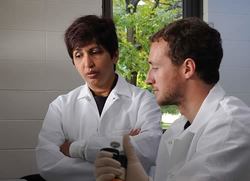Professor Kasturi Haldar has received the 2016 Rodney F. Ganey, Ph.D., Community-Based Research Award for a project that has helped improve rare disease recognition and treatment in northern Indiana. The award is a $5,000 prize presented annually to a regular faculty member at the University of Notre Dame who has completed at least one research project that addresses a need within South Bend or the surrounding area. Haldar is a molecular cell biologist and the Rev. Julius Nieuwland Professor of Biological Sciences and Parsons-Quinn director of the Boler-Parseghian Center for Rare and Neglected Diseases at the University of Notre Dame.
There are currently about 7,000 recognized rare diseases in the United States, and most medical clinicians will encounter only a small fraction of them even after years of practice in the clinic. So what does a clinician do when a patient with a rare disease appears in her clinic? She might reach out to a rare disease specialist or genetic center for support if she has easy access to either of those. They could provide her with the clinical spectrum of related rare diseases to review and compare with her patient’s symptomatology. But clinicians have demanding schedules and often no ready access to this kind of external support.
In northern Indiana, clinicians have long had to seek support for rare disease identification and diagnosis from Riley Children’s Health or Indiana University Health in Indianapolis. Because those facilities are distant and often busy, accessing them can be time-consuming, and the key to treatment of any disease is accurate and timely diagnosis and management.
So in 2015, a team led by Dr. Kasturi Haldar, director of the Boler-Parseghian Center for Rare and Neglected Diseases (CRND) at the University of Notre Dame, applied for and received a Ganey Collaborative Community-Based Research Seed Grant for a project to improve rare disease management and treatment locally. The grant helped her and her team partner with advanced pre-med students, local pediatricians, and families of rare disease patients, as well the National Organization of Rare Diseases, the Michiana Health Information Network, and CRND to create a knowledge base and analytic framework for rare disease recognition right here in northern Indiana.
 Haldar with student in her lab.
Haldar with student in her lab.
Using the combined resources of this partnership, Haldar and her team have developed a program that trains upper level pre-med students to evaluate rare disease patient medical records and help produce natural histories of disease. They then provide a local pediatric clinic with tools to strengthen the clinical context to manage and treat children with rare genetic disorders, empowering them with the most current data. This decreases the time to proper diagnostic understanding and the establishment of a clear course of treatment. The project also empowers patient families by providing clinicians with up to date information on centers of excellence and other resources that they share with patients. At the Annual Notre Dame Rare Disease Day Conference every February, students also partner with patients to present poster and community-based patient talks.
The project has clearly impacted pediatric health care for rare disease cases in northern Indiana, but its impact has also gone beyond the region. In 2015, Haldar’s team produced a case report of an unusual occurrence of neurofibromatosis (NF1), a rare genetic neurologic disorder. The report, “Aggressive Tibial Pseudarthrosis as Primary Symptom in Infant with Neurofibromatosis, which suggests need for modification of federal guidelines for NF1 diagnosis,” has now been published by Cold Spring Harbor Laboratory’s bioRxiv, where it will be available for review by the scientific community.
Contact: JP Shortall, jshortal@nd.edu
Originally published by at biology.nd.edu on April 17, 2017.